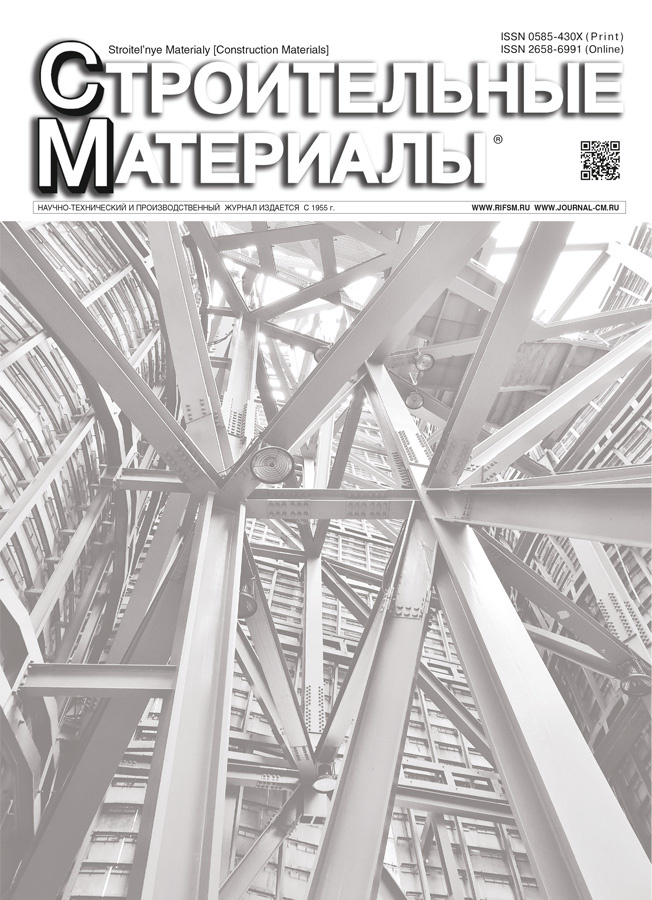Free-of-Cement Sulfate-Slag Binder with Increased Phosphoanhydrite Content
- Authors: Alfimova N.I.1, Levitskaya K.M.1,2, Elistratkin M.Y.1, Nikulin I.S.3, Buryanov A.F.3
-
Affiliations:
- Shukhov Belgorod State Technological University
- Belgorod National Research University
- National Research Moscow State University of Civil Engineering
- Issue: No 8 (2025)
- Pages: 37-44
- Section: Статьи
- URL: https://rjdentistry.com/0585-430X/article/view/690204
- DOI: https://doi.org/10.31659/0585-430X-2025-838-8-37-44
- ID: 690204
Cite item
Abstract
For the sustainable development of mankind, a necessary condition is the reduction of the volume of CO2 emissions, a significant share of which is created by the production of Portland cement. In this regard, the development of alternative products is relevant, one of which, experiencing its rebirth at a new stage of development, is sulfate-slag binder. The article considers the issues of obtaining its cement-free variety with an excess content of phosphoanhydrite, which acts as a sulfate activator of slag hardening. The possibility of obtaining water-resistant free-of-cement excess-sulfate-slag binders with a compressive strength of hardened stone up to 50 MPa has been established. The features of the structure formation processes and the nature of new formations of free-of-cement excess-sulfate-slag binders with a phosphoanhydrite content of 40% have been revealed. Based on the combination of properties, the developed binder can become an effective replacement for Portland cement when solving the problems of obtaining large volumes of concrete of medium strength classes with low heat generation and high sulfate resistance, in cases where it is possible to ensure a favorable temperature and humidity regime for 28–90 days. Cement-free excess-sulfate-slag binders have prospects for further development, their production and application will entail a significant positive environmental and economic effect, which will consist of the possibility of recycling phosphogypsum into a commercial product with high added value, reducing CO2 emissions into the environment, and freeing up territories occupied by waste storage.
Full Text
About the authors
N. I. Alfimova
Shukhov Belgorod State Technological University
Author for correspondence.
Email: alfimovan@mail.ru
Candidate of Sciences (Engineering), Associate Professor
Russian Federation, 46, Kostyukov St., Belgorod, 308012K. M. Levitskaya
Shukhov Belgorod State Technological University; Belgorod National Research University
Email: levickayalevickaya@gmail.com
Junior Researcher
Russian Federation, 46, Kostyukov St., Belgorod, 308012; 85, Pobeda St., Belgorod, 308015M. Yu. Elistratkin
Shukhov Belgorod State Technological University
Email: mr.elistratkin@yandex.ru
Candidate of Sciences (Engineering), Associate Professor
Russian Federation, 46, Kostyukov St., Belgorod, 308012I. S. Nikulin
National Research Moscow State University of Civil Engineering
Email: ivanikulin@yandex.ru
Candidate of Sciences (Engineering), Associate Professor
Russian Federation, 26, Yaroslavskoe Hwy, Moscow, 129347A. F. Buryanov
National Research Moscow State University of Civil Engineering
Email: rga-service@mail.ru
Doctor of Sciences (Engineering), Professor
Russian Federation, 26, Yaroslavskoe Hwy, Moscow, 129347References
- Salamanova M.Sh. Modern approaches to obtaining clinker-free binders of alkaline activation. Stroitel’nye Materialy [Construction Materials]. 2021. No. 9, pp. 48–53. (In Russian). EDN: IGBBIZ. https://doi.org/10.31659/0585-430X-2021-795-9-48-53
- Anand S., Vrat P., Dahiya R.P. Application of a system dynamics approach for assessment and mitigation of CO2 emissions from the cement industry. Journal of Environmental Management. 2006. Vol. 79 (4), pp. 383–398. https://doi.org/10.1016/j.jenvman.2005.08.007
- Bashmakov I.A., Potapova E.N., Borisov K.B., Lebedev O.V., Guseva T.V. Cement sector decarbonization and development of environmental and energy management systems. Stroitel’nye Materialy [Construction Materials]. 2023. No. 9, pp. 4–12. (In Russian). EDN: DVGDSP. https://doi.org/10.31659/0585-430X-2023-817-9-4-12
- Alfimova N.I., Levitskaya K.M., Elistratkin M.Yu., Bukhtiyarov I.Yu. Supersulphated cements: a review analysis of the features of properties, raw materials, production and application prospects. Vestnik of BSTU named after V.G. Shukhov. 2024. No. 7, pp. 8–24. EDN: QQDDQU. https://doi.org/10.34031/2071-7318-2024-9-7-8-24
- Wu Q., Xue Q., Yu Z. Research status of super sulfate cement. Journal of Cleaner Production. 2021. Vol. 294. 126228. EDN: YOXEKY. https://doi.org/10.1016/j.jclepro.2021.126228
- Liu S., Ouyang J., Ren J. Mechanism of calcination modification of phosphogypsum and its effect on the
- hydration properties of phosphogypsum-based supersulfated cement. Construction and Building Materials. 2020. Vol. 24320. 118226. EDN: QZVPDN. https://doi.org/10.1016/j.conbuildmat.2020.118226
- Juenger M.C.G., Winnefeld F., Provis J.L., Ideker J.H. Advances in alternative cementitious binders. Cement and Concrete Research. 2011. Vol. 41 (12), pp. 1232–1243. EDN: YCLVYR. https://doi.org/10.1016/j.cemconres.2010.11.012
- Levickaya K., Alfimova N., Nikulin I., Kozhukhova N., Buryanov A. The use of phosphogypsum as a source of raw materials for gypsum-based materials. Resources. 2024. Vol. 13. 69. EDN: XRXPKA. https://doi.org/10.3390/resources13050069
- Rashad A.M. Phosphogypsum as a construction material. Journal of Cleaner Production. 2017. Vol. 166, pp. 732–743. EDN: YJTHTS. https://doi.org/10.1016/j.jclepro.2017.08.049
- Alfimova N., Levickaya K., Nikulin I., Elistratkin M., Kozhukhova N., Anosov N. Effect of phosphogypsum origin and calcination temperature on characteristics of supersulfated cements. Journal of Composites Science. 2025. Vol. 025 (9). 146. EDN: TYOSKH. https://doi.org/10.3390/jcs9040146
- Wang Z., Sun T., Ouyang G., Li Z., Chen M., Li H., Wang K., Guo Y. Simultaneous enhanced phosphorus removal and hydration reaction: Utilisation of polyaluminium chloride and polyaluminium ferric chloride to modify phosphogypsum-based excess-sulphate slag cement. Journal of Cleaner Production. 2024. Vol. 476. 143712. EDN: BILTAR. https://doi.org/10.1016/j.jclepro.2024.143712
- Wang Z., Sun T., Ouyang G., Li H., Li Z., He J. Role of polyferric sulphate in hydration regulation of phosphogypsum-based excess-sulphate slag cement: A multiscale investigation. Science of The Total Environment. 2024. Vol. 948. 173750. EDN: FPSNLB. https://doi.org/10.1016/j.scitotenv.2024.173750
- Wang Z., Ouyang G., Li Z., Sun T., Li W., Deng Y., Chen J. Excess-sulphate phosphogypsum slag cement blended with magnesium ion: Part Ⅱ-the long-term microstructure characterisation and phase evolution. Construction and Building Materials. 2024. Vol. 431. 136513. EDN: NBMCRL. https://doi.org/10.1016/j.conbuildmat.2024.136513
- Couvidat J., Diliberto C., Meux E., Izoret L., Lecomte A. Greening effect of concrete containing granulated blast-furnace slag composite cement: Is there an environmental impact. Cement and Concrete Composites. 2020. 113. 103711. EDN: QMNMSQ. https://doi.org/10.1016/j.cemconcomp.2020.103711
Supplementary files













